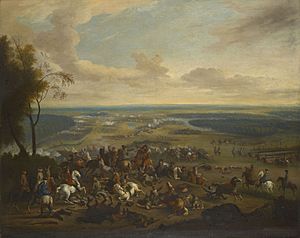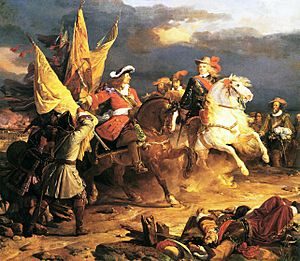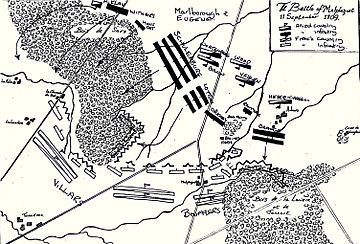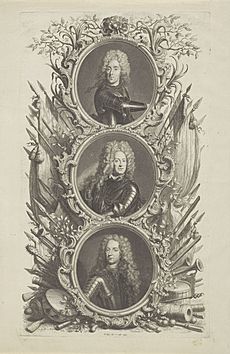Battle of Malplaquet facts for kids
Quick facts for kids Battle of Malplaquet |
|||||||
|---|---|---|---|---|---|---|---|
| Part of the War of the Spanish Succession | |||||||
 The Battle of Malplaquet, Jan van Huchtenburgh |
|||||||
|
|||||||
| Belligerents | |||||||
| Commanders and leaders | |||||||
|
|||||||
| Strength | |||||||
| 86,000 men, 100 guns | 75,000 men, 80 guns | ||||||
| Casualties and losses | |||||||
| c. 22,000 | c. 11,000 | ||||||
The Battle of Malplaquet was a huge and very bloody battle fought on September 11, 1709. It took place near a town called Taisnières-sur-Hon, in what is now France. This battle was part of a bigger conflict known as the War of the Spanish Succession.
In this battle, a French army of about 75,000 soldiers, led by the Duke of Villars, faced off against a larger force of 86,000 soldiers. This larger army was called the Grand Alliance, and it was led by the Duke of Marlborough. The Grand Alliance included soldiers from Great Britain, Austria, the Netherlands, and Prussia.
Malplaquet was one of the deadliest battles of the 1700s. The Grand Alliance won a victory, but they lost many soldiers. Even though the French lost, their army managed to retreat in good order. This battle had a big impact on the peace talks that followed.
Contents
Why the Battle Happened
France's Difficult Situation
By early 1709, France was in a tough spot. The country was running out of money, and a very cold winter in 1708-1709 caused a lot of hunger. Soldiers in French forts even started to protest because they didn't have enough food or pay.
Because of these problems, King Louis XIV of France wanted to end the war. He started peace talks with the Grand Alliance. He agreed to most of their demands, including letting the Habsburg family rule Spain instead of his grandson. However, he refused to use French troops to force his grandson out of Spain. Because of this, the peace talks failed.
Allied Plans
The Grand Alliance believed France was about to collapse. They wanted to keep attacking French forts along the border, known as the Frontière de fer. The Allied commander, Marlborough, decided to attack the strong French fortress of Tournai.
The siege of Tournai began in June and lasted until September 3. After Tournai surrendered, Marlborough quickly moved his army towards Mons. King Louis XIV ordered his general, Villars, to stop the Grand Alliance from taking Mons at all costs. The two armies met near Malplaquet on September 9.
The Battle of Malplaquet
Marlborough and his second-in-command, Prince Eugene, felt confident they could win. They believed a big victory would end the war. However, they delayed their attack until September 11. This gave Villars an extra day to build strong defenses, including earth walls and trenches in the woods.
Marlborough's Strategy
Marlborough had used a successful plan in earlier battles. He would attack the sides (flanks) of the French army. This would force the French to move soldiers from their middle (center) to help their flanks. Once the French center was weaker, Marlborough would send a large cavalry charge to break through it.
However, at Malplaquet, the French had very strong defenses. Their soldiers were also well-led and determined. Villars had learned from past defeats and made sure his army was concentrated. This made it harder for Marlborough to move his troops around quickly, which he often did to confuse his enemies.
The Armies
The French army had about 75,000 to 80,000 soldiers and 80 cannons. This included soldiers from Bavaria and Switzerland, as well as the Irish Brigade. Villars commanded the left side, while Marshal Louis-François de Boufflers led the right. The French infantry stood behind strong trenches, with their cavalry waiting behind them.
The Grand Alliance had about 86,000 soldiers and 100 cannons. Prince Eugene led about 30,000 German and Danish soldiers on the right side. The left side had 18,000 Dutch soldiers, led by the Prince of Orange. In the middle, the experienced Earl of Orkney commanded 8,000 mostly British soldiers. Most of the 30,000 cavalry were behind them.
The Battle Begins
The battle started at 7:00 AM on September 11 with a heavy cannon attack. At 8:30 AM, the Grand Alliance's right side attacked the French positions in Sars Wood. There were three hours of intense fighting, and both sides lost many soldiers. Prince Eugene was wounded in the neck but bravely stayed on the battlefield.
Around 9:00 AM, the Dutch soldiers attacked the French right side. They had some early success but were pushed back. The Prince of Orange then ordered more Dutch soldiers to attack French positions around Blairon Farm.
The Dutch managed to capture Blairon Farm, but they suffered over 5,000 casualties, including many officers. They fought with incredible bravery until Marlborough told the Prince of Orange to stop. The Dutch soldiers then pulled back. The Earl of Orkney later wrote that the Dutch dead were "as thick as ever you saw a flock of sheep."
Meanwhile, Prince Eugene's attacks forced Villars to move soldiers from the center of his army to help his left side. By midday, Villars had moved many soldiers, leaving his center weaker. This allowed Orkney to break through the French defenses in the early afternoon. Soon after, Villars was badly wounded and had to give command to Boufflers.
The Grand Alliance cavalry then moved forward. They were attacked by the best French cavalry, the Maison du Roi. The Grand Alliance cavalry was pushed back, but then the Allied infantry pushed the French back. The French left side finally started to crumble under pressure.
The Prince of Orange ordered another large attack on the French right side. Some Dutch cavalry broke through their lines, followed by the rest of the Allied cavalry. This led to the biggest cavalry battle of the 1700s. The French army began to retreat, and at 3:00 PM, Boufflers ordered a full retreat. The Grand Alliance soldiers were too tired to chase them.
Casualties
Most historians believe the Grand Alliance lost about 21,000 to 25,000 soldiers who were killed or wounded. The Dutch infantry alone suffered about 8,462 casualties.
There is less agreement on French losses, but most estimates are between 11,000 to 14,000 killed or wounded.
Aftermath

Even though the Grand Alliance lost many soldiers, people at the time saw Malplaquet as a victory. This was because they held the battlefield, and Mons surrendered on October 21. The French commanders focused on how many soldiers they had killed or wounded. Boufflers told King Louis XIV that even though they lost, it was a glorious defeat. Villars later said that if they lost another battle like this, all their enemies would be destroyed.
Some historians argue that Malplaquet was a strategic victory for France. Even though they lost Mons, the French army stayed mostly together. This allowed King Louis XIV to get better peace terms in 1713 than he could have in 1709.
Before the peace talks started again in 1710, Marlborough believed that their victory meant they could get any peace they wanted. He thought the French could only play defense after Malplaquet. In spring 1710, the Grand Alliance continued their advance. They captured several important French towns. Villars could not risk his last major French army in another battle.

The immediate impact of Malplaquet was more political than military. When peace talks restarted in March 1710, it was clear that people in Britain were changing their minds about the war. Even though British losses were not as high as the Dutch, Marlborough's opponents used the heavy casualties to attack him. People were tired of fighting for what seemed like small gains. This led to a big win for the Tories in the October 1710 election.
The Dutch blamed their heavy losses on Marlborough's tactics. The Prince of Orange was also criticized for continuing his attacks when the French defenses were too strong. However, he was still trusted to finish the siege of Mons, which surrendered in October. The Dutch felt that their many casualties meant they should demand even tougher peace terms from France.
In April 1711, the Habsburg candidate for the Spanish throne, Archduke Charles, became the Holy Roman Emperor. This made continuing the war seem pointless. Britain didn't want Spain to be united with Austria any more than they wanted it united with France. Even though the Grand Alliance captured another important French town in September 1711, the British secretly started negotiating peace directly with King Louis XIV. By the end of 1711, Marlborough was replaced, and British troops were ordered not to attack anymore.
Swiss soldiers fought on both sides in the battle. Six Swiss battalions fought with the French, and eight fought with the Dutch. More than 8,000 Swiss soldiers were killed or wounded. This caused a big debate in Switzerland. Malplaquet was the last time Swiss mercenaries fought directly against each other until a battle in 1808.
A book called Amiable Renegade: The Memoirs of Peter Drake (1671–1753) gives a firsthand account of the battle. Peter Drake was an Irishman who fought with the French cavalry at Malplaquet and was captured after being wounded. Another famous Irishman, Féilim Ó Néill, was killed fighting with the Irish Brigade.
Images for kids
-
The Pré carré line on the French northern border, defended by a line of fortresses known as the Ceinture de fer (marked in red and green); by the end of 1710, this line was badly compromised
-
Victory at Villaviciosa in December 1710 signalled the collapse of Allied ambitions in Spain and accelerated peace talks








